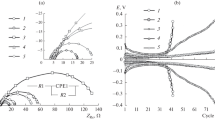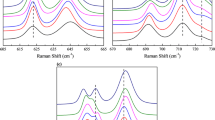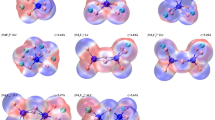Abstract
Solution condition of the lithium electrolyte of LiCF3SO3 salt dissolved in propylene carbonate (PC), dimethoxyethane (DME) and tetrahydrofuran (THF) were investigated based on the measurements of the self-diffusion coefficients of lithium (DLi) and anion (DF) species using the pulsed-field gradient (PFG) NMR, viscosity and conductivity. DLi and DF decreased with the increase in the solution concentration for these electrolytes. This result reflects the change in the dissociation degree of the salt and the viscosity depending on the solution concentration. In the case of PC solution (the dielectric constant (∈) of PC: ∼65), measured DLi and DF were separated each other with the decrease in the concentration because the dissociation of the salt was promoted to increase the content of dissociated ions. With an increase in the concentration, the dissociation would be restricted and DLi and DF approximated each other, which means that the associated ion pairs are dominant in the solution. The effective ionic radius (reff) of cation species of PC solution estimated from the Stokes-Einstein relation using the diffusion coefficient and the viscosity results was four times greater than that of the naked lithium ion and independent of the dissociation degree. On the other hand, the reff of anion species changed depending on the dissociation degree. This suggests that the dissociated lithium ions are solvated by the PC solvent in the solution. DME and THF solutions did not show the solvation effect from the result of the change in reff with the concentration. This suggests that the dissociation degree of the dissolved salt was low due to the low ∈ of their solvents (∈ ∼ 7.2) and the ion pairs would dominant in the solutions independent of the solution concentration.
Similar content being viewed by others
References
S. Bhattacharja, S. W. Smoot and D. H. Whitmore, Solid State Ionics 18/19 (1986) 306.
W. S. Price, Ann. Rep. NMR Spectroscopy 32 (1996) 51.
J. E. Tanner, J. Chem. Phys. 52 (1970) 2523.
P. Stilbs, Prog. NMR Spec. 19 (1987) 1.
W. S. Price, Concepts of Magn. Reson. 9 (1987) 299; ibid. 10 (1998) 197.
E. O. Stejskal and J. E. Taner,J. Chem. Phys. 42 (1965) 288.
M. Hola and H. Weingeartner, J. Magnetic Resonance 92 (1991) 115.
C. Capiglia, Y. Saito, H. Kageyama, P. Mustarelli, T. Iwamoto, T. Tabuchi and H. Tsukamoto, J. Power Source, 81-82 (1999) 772.
P. W. Atkins, “Physical Chemistry, Sixth edition” (Oxford University Press, 1998) p. 749.
M. Ue, J. Electrochem. Soc. 141 (1994) 3336.
Y. Matsuda, H. Nakashima, M. Morita and Y. Takasu, ibid. 128 (1981) 2552.
Author information
Authors and Affiliations
Rights and permissions
About this article
Cite this article
Saito, Y., Yamamoto, H., Kageyama, H. et al. Investigation of the solution condition of lithium electrolyte solutions with LiCF3SO3 salt. Journal of Materials Science 35, 809–812 (2000). https://doi.org/10.1023/A:1004717517628
Issue Date:
DOI: https://doi.org/10.1023/A:1004717517628




